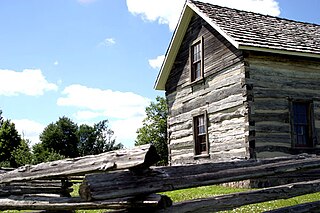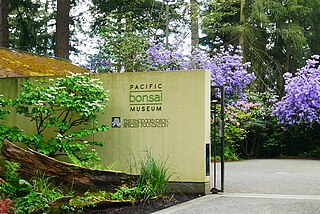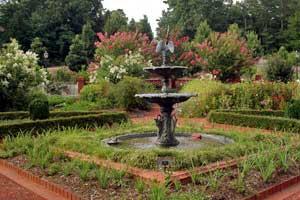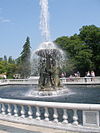
An arboretum is a botanical collection composed exclusively of trees of a variety of species. Originally mostly created as a section in a larger garden or park for specimens of mostly non-local species, many modern arboreta are in botanical gardens as living collections of woody plants and is intended at least in part for scientific study.

The United States National Arboretum is an arboretum in northeast Washington, D.C., operated by the United States Department of Agriculture's Agricultural Research Service. It was established in 1927 by an act of Congress after a campaign by USDA Chief Botanist Frederick Vernon Coville.

The Bartlett Arboretum and Gardens in Stamford, Connecticut, contains 93 acres of parkland, gardens, landscapes, and hiking trails that focus on the regional plants, ecology and character of Southwestern New England. The Arboretum is open and accessible to the public every day of the year and is located at 151 Brookdale Road.

The Harry P. Leu Gardens are semi-tropical and tropical gardens in Orlando, Florida, United States. The gardens contain nearly 50 acres (200,000 m2) of landscaped grounds and lakes, with trails shaded by 200-year-old oaks and forests of camellias. They are open to the public. The address is 1920 North Forest Avenue Orlando, FL 32803.

The Arboretum at Gustavus Adolphus College, also known as TheArboretum at Gustavus or colloquially as The Arb, is on the campus of Gustavus Adolphus College in Saint Peter, Minnesota, United States. It contains a number of botanical gardens and a 125 acre arboretum with its first trees planted as small seedlings in 1973 on agricultural land. The arboretum was formerly named for Carl Linnaeus, a Swedish botanist, from 1988 to 2021.
The Brenton Arboretum is a 141-acre arboretum and public garden in Dallas Center, Iowa, United States, established in 1997. The arboretum displays 175 native Iowa trees and shrubs suitable to the site, as well as many other tree species which can grow in central Iowa. The non-profit arboretum is open to the public from 9 am to sunset on Tuesday through Sunday, featuring a collection of over 2,600 trees and shrubs on display.
Hidden Lake Gardens colloquially known as Hidden Lake 755 acres (3.06 km2), is a botanical garden and an arboretum operated by Michigan State University situated in the Irish Hills of southeast Michigan. The Gardens are known for their large collection of native and nonnative trees, shrubs and flowers. HLG was given to Michigan State University by Harry Fee in 1945. Today it is visited by nearly 45,000 people annually. One facet of the Hidden Lake Gardens mission is "To preserve an undeveloped area of the scenic Irish Hills, providing a place of beauty and inspiration for public enjoyment."
The University of South Florida Botanical Gardens 15 acres are located on the campus of the University of South Florida in Tampa, Florida, United States, and consist of 7 acres of developed gardens plus 6 to 9 acres of natural greenbelt. It is a member of the American Public Gardens Association, American Horticulture Society Reciprocal Admissions Program, Greater Temple Terrace Chamber of Commerce, and Visit Florida and receives about 35,000 visitors annually. The gardens are open to the public during weekday business hours, and on shorter weekend hours. Admission is $5 for adults.

The Government Botanical Garden is a botanical garden in Udhagamandalam, near Coimbatore (Ooty), Tamil Nadu state, India laid out in 1848. The gardens, divided into several sections, cover an area of around 22 hectares, and lie on the lower slopes of Doddabetta peak. The garden has a terraced layout. It is maintained by the Tamil Nadu Horticulture Department.

The Fernwood Botanical Garden and Nature Preserve is an arboretum, botanical garden, and nature preserve located at 13988 Range Line Road in Buchanan Township, Michigan. It covers an area of 105 acres (42 ha). It is open to the public; an admission fee is charged.

The Dawes Arboretum is a nonprofit arboretum located in Newark, Ohio. It includes nearly 2,000 acres (8 km2) of plant collections, gardens and natural areas. The site includes approximately 12 miles (19 km) of hiking trails and roadways for a four-mile (6 km) driving tour.

Nichols Arboretum, locally known as the Arb, is an arboretum operated by the Matthaei Botanical Gardens and Nichols Arboretum (MBGNA) at the University of Michigan. Located on the eastern edge of its Central Campus at 1610 Washington Heights in Ann Arbor, Michigan, the Arboretum is a mosaic of University and City properties operated as one unit. The arboretum is open daily from sunrise to sunset with no charge for admission. The Huron River separates a northern section of the arboretum's floodplain woods; the railroad marks the northern border.

The Morton Arboretum, in Lisle, Illinois, United States, is a public garden and outdoor museum with a library, herbarium, and program in tree research including the Center for Tree Science. Its grounds, covering 1,700 acres, include cataloged collections of trees and other living plants, gardens, and restored areas, among which is a restored tallgrass prairie. The living collections include more than 4,100 different plant species. There are more than 200,000 cataloged plants.

Olbrich Botanical Gardens is a 16 acre outdoor botanical garden and 10,000-square-foot conservatory in Madison, Wisconsin. Founded in 1952 and named for its founder, Michael Olbrich, the gardens are owned and operated jointly by the City of Madison Parks and the non-profit Olbrich Botanical Society.

The University of Wisconsin–Madison Arboretum is a teaching and research facility of the University of Wisconsin–Madison and the site of historic research in ecological restoration. In addition to its 1,260 acres (5 km2) in Madison, Wisconsin, the Arboretum also manages 520 acres (210 ha) of remnant forests and prairies throughout Wisconsin. It was designated a National Historic Landmark in 2021, in recognition for its role as a pioneer in the field of ecological restoration.

The Rhododendron Species Foundation and Botanical Garden (RSBG) on 22–24 acres is a nonprofit botanical garden specializing in rhododendrons in Federal Way, Washington. As of 2006 the Foundation's mission is devoted to the conservation, research, acquisition, evaluation, cultivation, public display, and distribution of rhododendron species. The gardens contain over 10,000 rhododendrons, set out as a woodland garden among native conifers.

The University of Guelph Arboretum is an arboretum organized by the University of Guelph in Guelph, Ontario. It was formally established in 1970 by the university and aims to conserve biodiversity and connect people with nature through teaching, research, and community outreach. The space is 165 hectares and is open throughout the year.

The State Botanical Garden of Georgia is a botanical garden of 313 acres in the United States, with a conservatory operated by the University of Georgia. It is located at 2450 South Milledge Avenue, Athens, Georgia.

The Arboretum at Penn State, which contains the H.O. Smith Botanic Gardens, is a new arboretum at The Pennsylvania State University adjacent to its University Park campus in State College, Pennsylvania. It is Penn State's second arboretum, joining the Arboretum at Penn State Behrend, which was created in 2003.






























